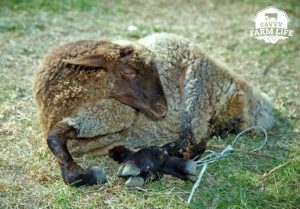
How to Take Care of a Leg Injury on a Sheep
If you keep sheep, or any livestock for that matter, you may have learned the hard way that injuries can occur, especially when it comes to your sheep’s legs and feet. It is best to prepare yourself for these occurrences and familiarize yourself with problems that can arise with sheep legs, and how to treat leg injuries.
How do you fix a sheep’s injured leg? The course of action you would take to treat an injury to a sheep’s leg largely depends on the injury itself. If your sheep has experienced a fracture, it is possible to reset the bones and cast the leg for recovery. If your sheep is experiencing a foot injury like foot scald or foot rot, you can treat this with antibiotics and a sterilized environment.
If you’re new to caring for sheep, facing a sheep with an injury can be daunting. In this article, I’ll walk you through how to spot and diagnose injury and the steps you can take to treat the specific injuries your sheep may face. Read on!
Signs Of Sheep Leg Injury
You may be wondering how you can tell if your sheep is suffering from a leg or foot injury. Sheep are prey animals, and prey animals will do everything they can to keep from showing signs of an injury or illness. In the wild, predators will target the injured or ill members of a herd or flock to hunt, as these animals are typically the weakest and the easiest to catch and overcome. Just because your sheep know nothing but your comfortable, safe pastures does not mean that they will not hold tight to this behavior, however. So much of animal (and human) behavior is instinctual, and your domesticated sheep will try just as hard to keep you from noticing an injury as their ancestors in the wild did.
For this reason, you likely will not know that your sheep’s leg is bothering her until she is no longer able to walk on the affected limb. If you notice your sheep limping, this is a sign that the leg is causing enough pain that your sheep can no longer bear weight on it. If your sheep is only walking on three legs, or if your sheep is lying down and unwilling to stand, it is important to inspect your sheep for injury immediately.
How To Inspect Your Sheep’s Leg And Feet for Injury
The first thing you will want to look for if you suspect a leg injury is an open wound. If you see an open wound that is deep enough or wide enough to require stitches (over approximately 1 inch in length, but always use your best judgement), you should call your vet so that the wound can be properly stitched, unless you have the means to do so yourself.
If you see no obvious signs of injury, you will want to take a close look at the feet, paying close attention to the skin between the claws. If you notice inflammation, redness, hoof wall separation, or a foul smell between the claws, your sheep may be suffering from scald or footrot.
If the feet look good, inspect the animal’s leg. Move the sheep’s joints to inspect for a fracture. Sometimes you might notice a complete, clean break. Or, you may notice a small fracture. Signs the leg may be injured can include swelling and soreness. A hard lump on the leg can be a bone chip or fracture. Either way, it is important to stabilize the leg as soon as possible to encourage healing.
How to Treat Scald And Footrot in Sheep
Both scald and footrot are bacterial infections that can affect the feet of sheep – with footrot usually causing more severe symptoms.
Foot Scald
Scald is the most common reason for lameness in sheep. Foot scald is caused by the bacterias Fusobacterium necrophorum and/or Actinomyces pyogenes – both common bacteria found in a typical livestock environment. This is usually more common in the wetter months of the year, and can flourish in damp environments.
When scald is present, you will notice swelling and a thin layer of white film between the claws of the affected foot. Soreness will usually be present as well, which will lead to the limping you have likely noticed.
Scald is manageable, and an oxytetracycline spray can be applied to the affected area if a single sheep or two are infected. If multiple sheep are affected, a footbath may be a more viable solution. For a footbath, you will want to have your flock walk through a solution of either 10% zinc sulphate or 3% formalin. Repeat the footbath weekly until the issue has resolved, and make sure to allow the solution to dry on your sheep’s feet. Do not use more than the recommended percentage, to avoid irritation and discomfort.
Footrot
 Footrot is similar to foot scald but is usually more severe. Footrot is caused by the bacterias Fusobacterium necrophorum and Dichelobacter nodusus. There are over 20 different strains of Dichelobacter nodusus in the United States, with some strains being more virulent (causing severe symptoms) than others.
Footrot is similar to foot scald but is usually more severe. Footrot is caused by the bacterias Fusobacterium necrophorum and Dichelobacter nodusus. There are over 20 different strains of Dichelobacter nodusus in the United States, with some strains being more virulent (causing severe symptoms) than others.
Footrot is usually very painful, and a sheep will not be able to use the limb to bear weight. Footrot is also found between the claws and will cause inflammation and a foul smell. Often, the hoof wall will become separated and you may discover foot deformities have developed.
To treat footrot, you will want to spray topical antibiotics. For more severe cases, you may also need to administer an antibacterial injection. Make sure to isolate the affected sheep, as the bacteria that causes this infection can survive off of its host for up to 12 days.
Sometimes, mild footrot may be mistaken for scald. It is believed that the less virulent strains of footrot will present like scald. However, these are two different infections, and the bacteria Dichelobacter nodusus that causes footrot is not present in scald.
Hearing about all the problems and injuries sheep face may make you wonder whether or not they are right for you. To help you way the pros and cons of owning sheep, visit my article How Hard is it to Raise Sheep? Sheep Raising Pros and Cons.
Sheep Leg Injuries: Treating Fractures
While sheep are typically hardy animals, leg fractures are not unheard of – particularly among lambs. Fortunately, there are steps you can take to encourage the bones to heal.
Closed Fractures
A closed fracture is one in which the bone has not broken through the skin. If you are going to be faced with treating a fracture, this is the one you should hope for! For proper healing, you will want to splint the limb as quickly as possible.
Both the joint above the break and the joint below the break will need to be immobilized. Measure the area between these joints and use that measurement to cut an appropriate splint. You can purchase a splint from your vet, or you can make one using ½” PVC pipe or other appropriate material (just make sure it is strong enough to immobilize the leg, and light enough for your sheep to carry around).
Do your best to “set” the break by moving the bones back into place. If the bones are not set properly, the bones may not be able to stitch back together and/or the leg can become deformed. Wrap the entire area that is to be splinted with a cotton wrap. Ensure that it is snug, but not so tight that it will cut off circulation. Keep the foot unwrapped if you can, both to check for swelling, and to discourage scald.
Once the leg is wrapped, place the splint against the limb and use more wrapping to secure the splint to the leg. Make sure to wrap the top and the bottom of the splint completely, so that it stays in place against the broken leg.
If the break is above the hock, you will want to bend the leg and tuck it against the body, securing it with the wrapping.
Keep your sheep isolated and confined until the bone is healed. This healing can happen as quickly as 3 weeks or may take as long as 6 weeks. The healing time will depend on the severity and location of the break, and the age of the sheep. Change the bandage weekly, or more often if it becomes wet. Check the bandage at least once a day to make sure everything is good.
As always, you should always consult a vet if you aren’t sure what you should do or you aren’t comfortable performing the treatment yourself.
Compound Fractures
A compound fracture is a break in which the bone has broken through the skin. The prognosis for broken bones that have been contaminated with bacteria is not as good as that of closed fractures. You will need to inspect the wound thoroughly and use your best judgement on how to proceed.
If the fracture is relatively clean and the open wound is small, you will want to flush and disinfect the wound. Once you have disinfected the area, let it dry and proceed the same way as you would with a closed fracture. If the open wound is larger than 1”, you will need to have it cleaned and stitched before setting and wrapping it.
If you are unsure whether the wound will heal, you should consult a vet. If healing is unlikely, you will want to consider either having the leg amputated or humanely euthanizing the animal. This decision is not one to be taken lightly, but it should be made quickly – even if your sheep is not showing outward signs of discomfort, you can be sure that any break is going to cause your sheep significant pain and suffering.
When To Call The Vet
When you have a flock of sheep, it is helpful to have a vet or experienced livestock keeper to turn to with questions or in the case of emergencies. If you have a large flock of sheep, you will likely become familiar with various injuries and illnesses as you gain experience, and will know when you can treat your sheep yourself, when to call a vet in, and when to euthanize. Whichever action you take, it is important that you act quickly to limit suffering and encourage the best outcome.
Did you know that another thing that can be potentially life-threatening for sheep is if they fall over? Sheep are like turtles in this way! To learn more, visit my article Sheep Falling Over: Causes, Prevention, & Tips.
